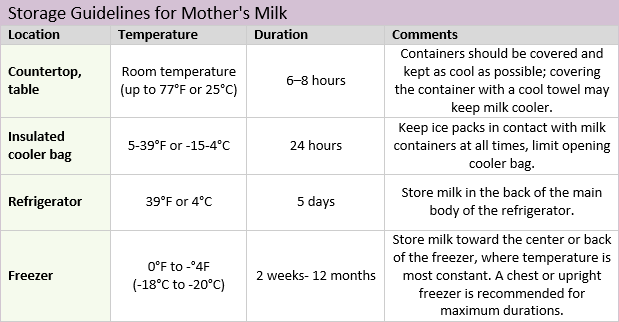8 Essential Tips to Store Your Breast Milk
Reading time: 4 minutes

Pumping creates a whole new set of challenges for moms. Once you’ve managed to pump successfully, you’re going to have to store that milk until your baby needs it. Here are a few helpful tips to make your life easier…
1. Follow proper storage guidelines
It’s important to know the proper temperatures and durations for which you can store milk. This guide gives you all the information you need. I recommend you print it out and tape it your refrigerator.

2. Don’t fill your bags or bottles completely
You want to leave some space at the top of the bag or bottle. Breast milk is mostly water, so it will expand when it freezes. If the container is already full, the milk could bust it open and spill out all of your hard work! The La Leche League recommends refrigerating or chilling milk right after it’s expressed.
3. Label the container carefully
Mark the date on the container clearly. This ensures that you use the oldest milk first and that you don’t feed your baby with any milk that has expired. If your child is in a day care setting, you’ll want to put their full name on the container so you make sure your child is getting your milk. If you’re pumping at work, make sure to label it clearly as breast milk so no one else uses it by mistake.
4. Place breast milk in the center of the freezer
The temperature along the edges (sides, top and bottom) of your freezer can fluctuate slightly. This happens because of proximity to the cooling unit, air escaping through cracks, and air escaping when the door opens. Store your milk in the center where the temperature is most consistent. This will prevent your milk from partially thawing and freezing over and over.
5. Don’t use disposable liners
While disposable drop-in liners, may be convenient for bottle feeding, they’re not recommended for long term milk storage for a few reasons: 1) You’ll need to transfer pumped milk into bottle liners prior to freezing and this extra step increases the likelihood of contamination 2) These types of bags are typically less durable than proper storage bags or bottles, so the risk of breaking open and spilling their contents is greater.
6. Always use BPA-free containers
BPA is a chemical used in the production of plastics. It can leach from the plastic into our products. It’s especially dangerous for developing children because it makes your body think it has enough estrogen, but it doesn’t fulfill estrogen’s function, so your baby would have a deficiency. Most children’s products are BPA-free, but check to be sure.
7. Warming your milk
Thaw and heat up your milk under warm, running water or in a bowl with warm water. Do not bring it to a boil, as this can destroy some of the nutrients in the liquid. Do not heat it up in a microwave. Gently swirl the liquid around before serving to evenly distribute the heat (as hot spots can burn).
8. Never re-freeze milk
Once thawed, milk can be kept in the fridge for 24 hours. After that, you should throw it away.
 Written by Melissa LaHann, Founder and CEO of Happy Fig, LLC
Written by Melissa LaHann, Founder and CEO of Happy Fig, LLC
Like many moms before her, Melissa cradled her hungry, crying baby as she clumsily adjusted her bra and sat uncomfortably holding up her shirt. Before she knew it, her baby was squirming, her shirt was falling, and the nursing session was interrupted. She needed a better solution, so she created LatchPal, the first nursing clip of its kind.
LatchPal is a breastfeeding shirt clip that holds up a mother’s shirt during breastfeeding. It eliminates shirt re-positioning and feeding disruptions, and helps a mom nurse hands-free in comfort to maximize milk flow. LatchPal was designed with moms in mind. The multi-use solution only requires one hand to latch. It’s a must-have breastfeeding accessory and essential for post-partum moms, pumping moms, and nursing in public.
Interested in writing a guest blog for LatchPal? Send your topic idea to pr@latchpal.com.
All data and information provided on this site is for informational purposes only. LatchPal makes no representations as to accuracy, completeness, current-ness, suitability, or validity of any information on this site and will not be liable for any errors, omissions, or delays in this information or any losses, injuries, or damages arising from its display or use. All information is provided on an as-is basis.
























